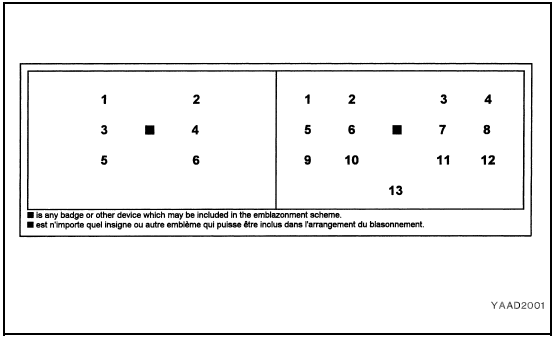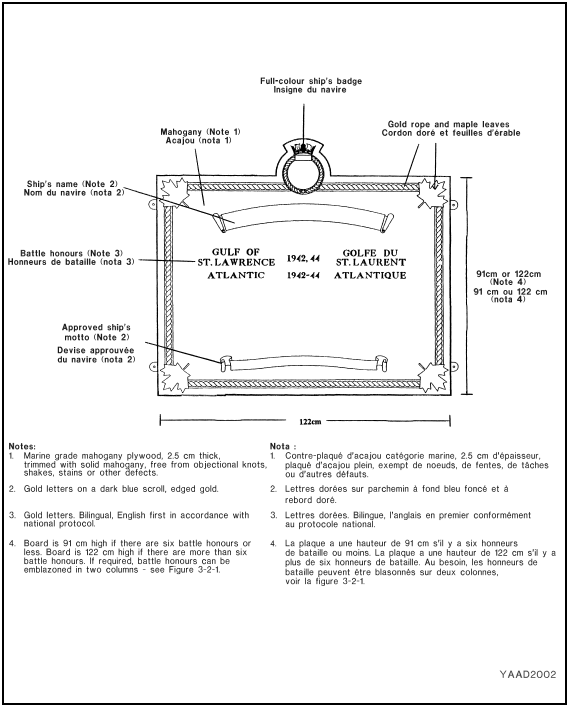Heritage Structure | Section 3 – Display of honours
NOTE
ChAll of Chapter 3 should be considered as being a change.
- Policy. All battle honours are equal and are recorded and displayed equally in orders and documents and on plaques, signs, and stationary, etc., in the order in which they were won. Special regulations applicable to specific types of recording and display are noted in this section. Refer to Section 2 for general information on the display of honours.
- Emblazonment Style. The sequence of emblazonment is illustrated in Figure 3-3-1.

Figure 3-3-1 Emblazonment Sequence
- Her Majesty's Canadian Ships – Battle Honour Boards. Battle honours awarded to HMC ships are listed in A-AD-267-000/AF-002, Insignia and Lineages of the Canadian Forces (Part 1 – Extant Commissioned Ships); and (Part 2 – Paid Off Commissioned Ships), and shall be displayed on the ship's battle honour board and recorded in the Captain's Ship's Book.
- Battle honour boards are constructed to the standard design illustrated in Figure 3-3-2, and displayed on the ships' quarterdecks where they can be under the supervision of the regulating or gangway staff.
- Boards are normally manufactured as part of new construction. Commander Maritime Command shall appoint an Assistant Inspector of CF Colours and Badges who will ensure, on behalf of the Inspector of CF Colours and Badges, that battle honour boards are manufactured in accordance with this instruction and the sealed pattern held by the inspector. Repair, replacement and retirement procedures for battle honour boards are established by Commander Maritime Command and coordinated by the Maritime Command Assistant Inspector of CF Colours and Badges.

Figure 3-3-2 Ship’s Battle Honour Board
- Regiments – Colours and Appointments. Battle honours are displayed on Colours or regimental appointments. Originally, all honours could be displayed, but the number won in the lengthy campaigns of the First World War led to limits on the number, which can now be emblazoned on these particular items (Figure 3-3-3). Elsewhere, if space permits, all honours can be displayed.
- For infantry regiments with a stand of Colours, battle honours are emblazoned only on the regimental Colour except in the case of foot guards, which emblazon honours on both Colours. British Army Order 338 of 1922 permits “with His Majesty's approval – the carrying of honours on King's Colours...including Canadian regiments,” but this has not yet been necessary.
- Unit appointments include cap badges and various full dress items such as cross belt plates. Battle honours are normally only emblazoned on the appointments of rifle regiments, since these units do not carry Colours.
- The battle honours that each regiment has selected to be displayed on Colours or appointments are authorized by bold type in A-AD-267-000/AF-003. Requests to change these selections must originate from regiments and be approved by NDHQ/DHH on the recommendation of the branch advisor.
- Flying Squadrons – Standards. Battle honours are emblazoned on flying squadron Standards, with a maximum of eight honours displayed for the Second World War. (Elsewhere, if space permits, all honours may be displayed.) Squadrons with more than eight Second World War honours select those to be displayed by choosing primary honours first, followed by subsidiary honours where necessary to bring the total to eight (Figure 3-3-3). The battle honours selected are authorized by bold type in A-AD-267-000/AF-004. Requests to change these selections must originate from squadrons and be approved by NDHQ/DHH on the recommendation of the branch advisor.
NOTE
Only Royal devices and national honours and symbols are authorized for emblazonment on Colours and unit appointments. Personal symbols and departmental honours, which include the Commander-in-Chief Unit Commendation, the CF Unit Commendation, Command Commendations, etc., shall not be authorized for display on Colours and unit appointments.
| Regimental Colours | Flying Squadron Standards | |
|---|---|---|
| Prior to 1914 | no limit | N/A |
| The First World War | 10 | N/A |
| The Second World War | 10 | 8 |
| United Nations Operations – Korea 1950-1953 | 2 | N/A |
| Special Duty Area/Persian Gulf | N/A | no limit |
| Special Duty Area/Balkans | N/A | no limit |
- Colour Belts. Colour belts are issued plain, or for Air Command and flying squadron Standards, with minimal emblazonment. Further emblazonment, including battle honours, is at unit, not public, expense. Emblazonment style is a matter of unit custom rather than regulation, but, as a guide, follows the same sequence used on drum majors' belts (refer to paragraph 7.a.).
- Band Equipment. Band equipment may be emblazoned with battle honours and honorary distinctions at unit, not public expense. Emblazonment style follows conventional military protocol as detailed below.
- Drum Major's Belts (Sashes). The normal sequence of devices used on drum major sashes is:
- Crown and Royal Cypher;
- Arms of Canada;
- unit title, including battalion numeral if applicable;
- unit badge or badge central device;
- battle honours (if space is limited, the conventions for emblazonment on Colours apply – see Figure 3-3-3); and
- additional authorized devices, such as honorary distinctions.
- Drums. Drums are issued at public expense to authorized bands. The “ground” of the drum should be issued or painted in the unit's facing colour. The “rear/reverse” panel or apron is normally painted in the unit's full dress tunic colour (see A-AD-265-000/ AG-001), depending on the composition (wood or composite material). Drums are emblazoned as follows:
- Drum Shells. Shell emblazonment style follows two standard patterns for instant recognition. The first features the full Arms of Canada, with the organizations badge below (used for all drum types). The second pattern features the organizations badge enlarged (used for side and tenor drums). On bass drum shells, the battle honours are displayed beneath other markings. On side and tenor drums, and on kettledrum banners, the battle honours are displayed on either side of other markings. Both patterns are illustrated in Figure 3-3-4.
- Drum Heads. Drumheads shall not be emblazoned. Bands in possession of emblazoned drumheads shall order replacement heads through the CF supply system.
- Drum Hoops. Drum hoops, when fitted, may be painted in the national pattern, imperial pattern or similar patterns using facing or camp flag colours (see Figure 3-3-4).
- Further Guidance. Refer to A-AD-202-001/ FP-000, Volume 1: Band Instructions.
- Drum Major's Belts (Sashes). The normal sequence of devices used on drum major sashes is:

Figure 3-3-4 Drum Emblasonment